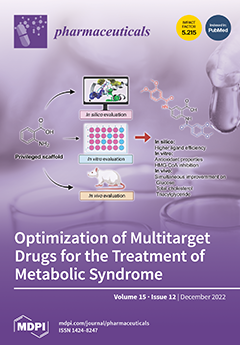As the ninth leading cause of death globally, diabetes mellitus (DM) is considered to be the worst chronic metabolic disease requiring an enormous need for healthcare with over 578 million expected cases by 2023. Several recent findings have demonstrated that mediating the activity of carbohydrate-hydrolyzing enzymes, including α-amylase and α-glucosidase, could be a potential strategy for managing the development of DM. In the presented study, a novel set of 1,3,5-trisubstituted-2-thioxoimidazolidin-4-ones was designed, synthesized, and characterized. The antidiabetic activity of the synthesized compounds was explored by assessing their inhibitory activity toward α-amylase and α-glucosidase enzymes. The results demonstrated that this class of compounds exhibits considerable inhibitory activity toward both α-amylase and α-glucosidase enzymes. Among the synthesized compounds, compound
5a demonstrated the most inhibitory activity with IC
50 of 5.08 and µg/mL and 0.21 µg/mL toward α-glucosidase and α-amylase activities, respectively, as compared to the drug Acarbose (IC
50 = 5.76 µg/mL and 0.39 µg/mL, respectively). To gain insights into the antidiabetic potential of compound
5a, we assessed the cytotoxic and antioxidant activities. Our findings indicated that compound
5a displays considerable cytotoxicity toward WI-38 cells with an IC
50 of 88.54 µg/mL, as compared to the drug Celecoxib (IC
50 = 93.05 µg/mL). Further, compound
5a exhibited a high scavenging activity toward 2,2-Diphenyl1-picrylhydrazyl (DPPH) free radicals (IC
50 = 51.75 µg/mL) and showed a low potential to produce ROS as indicated by the monitoring of the generated H
2O
2 (132.4 pg/mL), as compared to Trolox (IC
50 = 58.09 µg/mL) and Celecoxib (171.6 pg/mL). Finally, we performed extensive molecular modeling studies to affirm the binding affinity of this class of compounds to the binding pocket of α-amylase and α-glucosidase enzymes. Collectively, our findings indicate that this class of compounds, particularly compound
5a, could be utilized as a lead structure for the development of novel compounds with potential antidiabetic and antioxidant activities.
Full article






